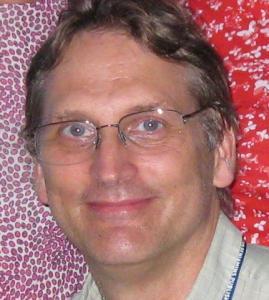
Eric Pederson
Education
Ph.D. (Linguistics) University of California, Berkeley, November 1991
Thesis: “Subtle semantics: Universals in the polysemy of reflexive and causative constructions.”
(with E. Sweetser, G. Lakoff, D. Slobin)
M.A. (Linguistics) University of California, Berkeley, December 1985
Thesis: “Intensive and expressive language in White Hmong (Hmoob dawb).” (with J. Matisoff)
B.A. (Linguistics) University of California, Berkeley, June 1982
Statement
Specializations: Psycholinguistics, semantics, typology, anthropological linguistics, Dravidian languagesPh.D. (Linguistics): University of California, Berkeley, 1991 E-mail: epederso AT uoregon DOT edu (no n in epederso)Office Hours: Fall 2019 Wednesdays 9:00-11:00; Fridays 10:00-11:00; by appointment otherwise
Publications
SELECTED PUBLICATIONS:Prakaiwan Vajrabhaya and Eric Pederson. 2018. “Teasing apart listener-sensitivity: The role of interaction.” Gesture 17(1): 65-97. RefereedPederson, E. 2016. “Approaches to motion event typology” in The Cambridge Handbook of Linguistic Typology, A. Y. Aikhenvald and R. M. W. Dixon, eds.Pederson, E. 2013. “The Kurumba Languages” in Encyclopedia of the Nilgiri Hills, Vol 1. Paul Hockings, ed. New Delhi: Manohar Books; Walnut Creek, CA: AltaMira Press.Pederson, E. 2012. The expression of space across languages. In: C. Maienborn & K. von Heusinger & P. Portner (eds.). Semantics. An International Handbook of Natural Language Meaning. Vol. 3. Berlin: de Gruyter, 2608-2624.Bohnemeyer, J. and E. Pederson, eds. 2011. Event Representation in Language and Cognition. In the series “Language, Culture, and Cognition”. Cambridge University Press.Pederson, E. and Guion-Anderson S.G. 2010. “Orienting attention during phonetic training facilitates learning.” Journal of the Acoustic Society of America 127 (2): 1-6. RefereedPederson, E. 2010. “Linguistic Relativity” in The Oxford Handbook of Linguistic Analysis. Bernd Heine and Heiko Narrog, eds. Oxford University Press: 733-752.Lautenschütz, A-K, C. Davies, M. Raubal, A. Schwering, & E. Pederson. 2008. “The Influence of Scale, Context and Spatial Preposition in Linguistic Topology”. In Th. Barkowsky et al., eds. Spatial Cognition V: Reasoning, Action, Interaction. Berlin: Springer-Verlag: 439-452. RefereedGuion, S.G. & Pederson, E. 2007. “Investigating the role of attention in phonetic learning”. In Festschrift for James E. Flege. O.-S. Bohn and M. Munro, eds. Benjamins. RefereedPederson, E. 2006. “Tamil spatial language.” In S. Levinson and D. Wilkins, eds. The grammars of space: 400-436. Cambridge University Press. RefereedPederson, E. 2003. “How many reference frames?” in C. Freksa et al., eds. Spatial Cognition 3: 287-304. Berlin: Springer-Verlag. RefereedPederson, E. 2003. “Mirror-image discrimination among nonliterate, monoliterate, and biliterate Tamil speakers.” Written Language and Literacy. 6(1): 71-91. RefereedDavies, C. and E. Pederson. 2001. “Grid patterns and cultural expectations in urban wayfinding” In Daniel R. Montello, ed. Spatial Information Theory: 400-414. Berlin: Springer-Verlag. Refereed.Danziger, E. and E. Pederson. 1998. “Through the Looking Glass: Literacy, writing systems and mirror image discrimination.” Written Language and Literacy 1(2): 153-164. Refereed.Pederson, E., E. Danziger, S. Levinson, S. Kita, G. Senft, and D. Wilkins. 1998. “Semantic typology and spatial conceptualization.” Language 74(3): 557-589. Refereed.Nuyts, J. and E. Pederson, eds. 1997. Language and conceptualization. Cambridge University Press. RefereedPederson, E. 1995. “Language as context, language as means: Spatial cognition and habitual language use.” Cognitive Linguistics 6(1): 33-62. Refereed.Pederson, E. 1993. “Geographic and manipulable space in two Tamil linguistic systems.” In Andrew U. Frank and Irene Campari, eds.. Spatial Information Theory: 294-311. Berlin: Springer-Verlag. Refereed.

